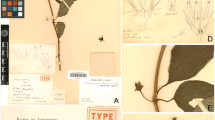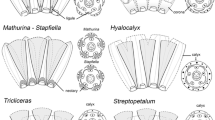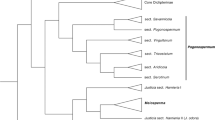Abstract
This paper critically reviews the homologies and distribution of tapetum types in monocotyledons, in relation to their systematics. Two main types of tapetum are widely recognised: secretory and plasmodial, although intermediate types occur, such as the “invasive” tapetum described inCanna. In secretory tapeta, a layer of cells remains intact around the anther locule, whereas in the plasmodial type a multinucleate tapetal plasmodium is formed in the anther locule by fusion of tapetal protoplasts. In invasive tapeta, the cell walls break down and tapetal protoplasts invade the locule without fusing to form a plasmodium. When examining tapetum type, it is often necessary to dissect several developmental stages of the anthers. Secretory and plasmodial tapeta are both widely distributed in monocotyledons and have probably evolved several times, although there may be some systematic significance within certain groups. Among early branching taxa,Acorus andTofieldia have secretory tapeta, whereas Araceae and Alismatales are uniformly plasmodial. The tapetum is most diverse within Commelinanae, with both secretory and plasmodial types, and some Zingiberales have an invasive tapetum. Lilianae (Dioscoreales, Liliales, and Asparagales) are almost uniformly secretory.
Similar content being viewed by others
Literature Cited
Arkal, G. D. &S. N. Ramaswamy. 1973. Embryology ofBurmannia pusilla (Wall. ex Miers) THW. and its taxonomic status. Beitr. Biol. Pflanzen 49: 35–46.
——. 1980. Embryology ofEriocaulon hookerianum Stapf, and the systematic position of Eriocaulaceae. Bot. Not. 133: 295–309.
Asplund, I. 1972. Embryological studies in the genusTypha. Svensk Bot. Tidsk. 66: 1–17.
Blackmore, S. &P. R. Crane. 1988. The systematic implications of pollen and spore ontogeny. Pages 83–115in C. J. Humphries (ed.), Ontogeny and systematics. Colombia University Press, New York.
Boehm, K. 1931. Embryologische Untersuchungen an Zingiberaceen. Planta 14: 411–440.
Carneil, K. 1952. Das Verhalten der Kerne im Tapetum der Angiospermen mit besonder Berücksichtigung von Endenmitosen und sogenannten Endomitosen. Österr. Bot. Zeit. 99: 318–362.
—. 1963. Das Antherentapetum. Österr. Bot. Zeit. 110: 145–176.
Chase, M. W., M. R. Duvall, H. G. Hills, J. G. Conran, A. V. Cox, L. E. Eguiarte, J. Hartwell, M. F. Fay, L. R. Caddick, K. M. Cameron &S. Hoot. 1995a. Molecular systematics of Lilianae. Pages 109–137in P. J. Rudall et al. (eds.), Monocotyledons: systematics and evolution. Royal Botanic Gardens, Kew.
—,D. W. Stevenson, P. Wilkin &P. J. Rudall. 1995b. Monocot systematics: a combined analysis. Pages 685–730in P. J. Rudall et al. (eds.), Monocotyledons: systematics and evolution. Royal Botanic Gardens, Kew.
—,P. J. Rudall &J. G. Conran. 1996. New circumscriptions and anew family of asparagoid lilies: genera formerly included in Anthericaceae. Kew Bull. 51: 667–680.
Cheah, C. H. &B. C. Stone. 1975. Embryo sac and microsporangium development inPandanus (Pandanaceae). Phytomorphology 25: 228–238.
Clément, C. & J. C. Audran. 1993a. Cytochemical and ultrastructural evolution of orbicules inLilium. Pl. Syst. Evol. (Suppl.) 7: 63–74.
——. 1993b. Orbicule wall surface characteristics inLilium (Liliaceae). An ultrastructural and cytochemical approach. Grana 32: 348–353.
Cooper, D. C. 1933. Nuclear divisions in the tapetal cells of certain angiosperms. Amer. J. Bot. 20: 358–364.
Dahlgren, R. M. T. &T. Clifford. 1982. The monocotyledons: a comparative study. Academic Press, London.
—— &P. F. Yeo. 1985. The families of the monocotyledons. Springer-Verlag, Berlin.
Davis, G. L. 1966. Systematic embryology of the angiosperms. John Wiley, New York.
Ducker, S. C., J. M. Pettitt &R. B. Knox. 1978. Biology of Australian seagrasses: pollen development and submarine pollination inAmphibolis antarctica andThalassodendron ciliatum (Cymodoceaceae). Austral. J. Bot. 26: 265–285.
Dunbar, A. 1973. Pollen development in theEleocharispalustris group (Cyperaceae). I. Ultrastructure and ontogeny. Bot. Not. 126: 197–254.
Echlin, P. 1971. The role of the tapetum during microsporogenesis of angiosperms. Pages 41–61in J. Heslop-Harrison (ed.), Pollen: development and physiology. Butterworths, London.
— &H. Godwin. 1968. The ultrastructure and ontogeny of pollen inHelleborus foetidus L. I. The development of the tapetum and Ubisch bodies. J. Cell Sci. 3: 161–174.
Garrigues, M. R. 1951. Sur les anomalies mitotiques du tapis des étamines. Rev. Gén. Bot. Paris 58: 305–318.
Geerinck, D. 1968. Considérations taxonomiques au sujet des Haemodoraceae et des Hypoxidaceae (Monocotyledones). Bull. Soc. Roy. Bot. Belg. 101: 265–278.
Grayum, M. H. 1987. A summary of evidence and arguments supporting the removal ofAcorus from the Araceae. Taxon 36: 723–729.
Hamann, U. 1966. Embryologische, morphologische-anatomische und systematische Untersuchungen an Philydraceen. Willdenowia 4: 1–178.
Hayashi, Y. 1960. On the microsporogenesis and pollen morphology in the family Magnoliaceae. Sci. Rep. Tôhoku Univ. Ser. IV (Biol.) 26: 45–52.
Heslop-Harrison, J. &H. G. Dickinson. 1969. Time relationships of sporopollenin synthesis associated with tapetum and microspores inLilium. Planta 84: 199–124.
Hesse, M. 1993. Pollenkitt development and composition inTilia platyphyllos (Tiliaceae) analysed by conventional and energy filtering TEM. Pl. Syst. Evol. (Suppl.) 7: 39–52.
— &M. W. Hess. 1993. Recent trends in tapetum research. A cytological and methodological review. Pl. Syst. Evol. (Suppl.) 7: 127–145.
Huysmans, S., G. El-Ghazaly &E. Smets. 1998. Orbicules in angiosperms. Morphology, function, distribution, and relation with tapetum types. Bot. Rev. (Lancaster) 64: 240–272.
Islam, A. S. 1950. A contribution to the life history ofOttelia alismoides Pers. J. Indian Bot. Soc. 29: 79–91.
Keijzer, C. J. &M. T. M. Willemse. 1988. Tissue interactions in the developing locule ofGasteria verrucosa during microsporogenesis. Acta Bot. Neerl. 37: 493–508.
Kircher, P. 1986. Untersuchungen zur Blüten-und Infloreszenzmorphologie, Embryologie und Systematik der Restionaceen im Vergleich mit Gramineen und verwandten Familien. Diss. Bot. 94: 1–218.
Kirpes, C. C., L. G. Clark &N. R. Lersten. 1996. Systematic significance of pollen arrangement in microsporangia of Poaceae and Cyperaceae: review and observations on representative taxa. Amer. J. Bot. 83: 1609–1622.
Kress, W. J. 1986. Exineless pollen structure and pollination systems of tropicalHeliconia (Heliconiaceae). Pages 329–345in S. Blackmore & I. K. Ferguson (eds.), Pollen and spores: form and function. Linnean Society Symposium Series No. 12. Academic Press, London.
— &D. E. Stone. 1982. Nature of the sporoderm in monocotyledons, with special reference to the pollen grains ofCanna andHeliconia. Grana 21: 129–148.
Kronestedt-Robards, E. C. &J. R. Rowley. 1989. Pollen grain development and tapetal changes inStrelitzia regime (Strelitziaceae). Amer. J. Bot. 76: 856–870.
Maheshwari, P. 1950. An introduction to the embryology of the angiosperms. McGraw-Hill, New York.
Mascré, M. &R. Thomas. 1930. Le tapis staminal (assise nourricière du pollen) chez les angiospermes. Bull. Soc. Bot. France 47: 654–664.
Mepham, R. H. &G. R. Lane. 1969. Formation and development of the tapetal periplasmodium inTradescantia bracteata. Protoplasma 68: 175–192.
Mdller-Doblies, U. 1969. Über die Blütenstüde und Blüten souie zur Embryologie vonSparganium. Bot. Jahrb. Syst. 89: 359–450.
Nanda, K. &S. C. Gupta. 1977. Development of tapetal periplasmodium inRhoeo spathacea. Phytomorphology 27: 308–314.
Pacini, E. 1997. Tapetum character states: analytical keys for tapetum types and activities. Canad. J. Bot. 75: 1448–1459.
— &G. G. Franchi. 1983. Pollen grain development inSmilaxaspera L. and possible functions of the loculus. Pages 183–190in D. L. Mulcahy & E. Ottaviano (eds.), Pollen: biology and implications for plant breeding. Elsevier, Amsterdam.
— &B. E. Juniper. 1983. The ultrastructure of the formation and development of the amoeboid tapetum inArum italicum Miller. Protoplasma 117: 116–129.
—,G. G. Franchi &M. Hesse. 1985. The tapetum: its form, function and possible phytogeny in Embryophyta. Pl. Syst. Evol. 149: 155–185.
—,P. E. Taylor, M. B. Singh &R. B. Knox. 1992. Development of plastids in pollen and tapetum of rye-grass,Lolium perenne L. Ann. Bot. 70: 179–188.
Panchaksharappa, M. G. 1962. Embryological studies in the family Zingiberaceae. I.Costus speciosus. Phytomorphology 12: 418–430.
Pettitt, J. M. 1981. Reproduction in seagrasses: pollen development inThallasia hemprichii, Halophila stipulacea andThalassodendron ciliatum. Ann. Bot. 48: 609–622.
— &A. C. Jermy. 1975. Pollen in hydrophilous angiosperms. Micron 5: 377–405.
Rowley, J. R. &A. Dunbar. 1996. Pollen development inCentrolepis aristata (Centrolepidaceae). Grana 35: 1–15.
— &J. J. Flynn. 1990–1991.Tambourissa (Monimiaceae). Microspore development in the tetrad period. Ann. Sci. Nat. Bot. Paris, 13 sér, 11: 125–147.
— &J. J. Skvarla. 1986. Development of the pollen grain wall inCanna. Nordic J. Bot. 6: 39–65.
—,N. I. Gabarayeva &B. Walles. 1992. Cyclic invasion of tapetal cells into loculi during microspore development inNymphaea colorata (Nymphaeaceae). Amer. J. Bot. 79: 801–808.
Rudall, P. J. &M. W. Chase. 1996. Systematics of Xanthorrhoeaceaesensu lato: evidence for polyphyly. Telopea 6: 629–647.
— &L., Clark. 1992. The megagametophyte in Labiatae. Pages 65–84in R. M. Harley & T. R. Reynolds (eds.), Advances in labiate science. Royal Botanic Gardens, Kew.
— &C. A. Furness. 1997. Systematics ofAcorus: ovule and anther. Int. J. Pl. Sci. 158: 640–651.
——,M. W. Chase &M. F. Fay. 1997. Microsporogenesis and pollen sulcus type in Asparagales (Lilianae). Canad. J. Bot. 75: 408–430.
-,D. W. Stevenson & H. P. Linden In press. Structure and systematics ofHanguana, a monocotyledon of uncertain affinity. Australian Systematic Botany 11.
—,M. W. Chase, D. F. Cutler, J. Rusby &A. de Bruijn. 1998. Anatomical and molecular systematics of Asteliaceae and Hypoxidaceae. Bot. J. Linn. Soc. 127: 1–42.
Sachar, R. C. &U. Arora. 1963. Some embryological aspects ofAmomum dealbarum andHedychium acuminatum. Bot. Gaz. 124: 353–360.
Simpson, M. G. 1989. Pollen wall development ofXiphidium coentleum (Haemodoraceae) and its systematic implications. Ann. Bot. 64: 257–269.
Smith, F. H. 1933. Nuclear divisions in the tapetal cells ofGaltonia candicans. Amer. J. Bot. 20: 341–347.
Spurr, A. R. 1969. A low-viscosity epoxy resin embedding medium for electron microscopy. J. Ultrastr. Res. 26: 31–43.
Stenar, H. 1925. Embryologische Studien I u. II.-I. Zur Embryologie einiger Columniferen. II. Die Embryologie der Amaryllideen. Akademische Abhandlung Uppsala, Uppsala.
—. 1927. Zur Entwicklungsgeschichte der gattimgAnigosanthus Labill. Bot. Not. 1927: 104–114.
Stevenson, D. W. &H. Loconte. 1995. Cladistic analysis of monocot families. Pages 543–578in P. J. Rudall et al. (eds.), Monocotyledons: systematics and evolution. Royal Botanic Gardens, Kew.
— &S. J. Owens. 1978. Some aspects of the reproductive morphology ofGibasis venustula (Kunth) D. R. Hunt (Commelinaceae). Bot. J. Linn. Soc. 77: 157–175.
Stone, D. E., S. C. Sellers &W. J. Kress. 1979. Ontogeny of exineless pollen inHeliconia, a banana relative. Ann. Missouri Bot. Gard. 66: 701–730.
———. 1981. Ontogenetic and evolutionary implications of a neotenous exine inTapeinochilos (Zingiberales: Costaceae) pollen. Amer. J. Bot. 68: 49–63.
Theilade, I. &J. Theilade. 1996. Ontogeny of pollen grains inZingiber spectabile (Zingiberaceae). Grana 35: 162–170.
Tiwari, S. C. &B. E. S. Gunning. 1986a. Development of tapetum and microspores inCanna L.: an example of an invasive but non-syncytial tapetum. Ann. Bot. 57: 557–563.
——. 1986b. Cytoskeleton, cell surface and the development of invasive plasmodial tapetum inTradescantia virginiana L. Protoplasma 133: 89–99.
——. 1986c. An ultrastructural, cytochemical and immunofluorescence study of post meiotic development of plasmodial tapetum inTradescantia virginiana L. and its relevance to the pathway of sporopollenin secretion. Protoplasma 133: 100–114.
——. 1986d. Colchicine inhibits plasmodium formation and disrupts pathways of sporopollenin secretion in the anther tapetum ofTradescantia virginiana L. Protoplasma 133: 115–128.
——. 1986e. Development and cell surface of a non-syncytial invasive tapetum inCanna: ultrastructural, freeze-substitution, cytochemical and immunofluorescence study. Protoplasma 134: 1–16.
Van der Ham, R. W. J. M. 1991. Pollen morphology of the Stemonaceae. Blumea 36: 127–159.
Wirz, H. 1910. Beitrage zur Entwicklungsgeschichte vonSciaphila spec. und vonEpirrhizanthes elongata Bl. Flora 101: 395–446.
Wunderlich, R. 1954. Über das Antherentapetum mit besonderer Berücksichtigung seiner Kernzahl. Österr. Bot. Zeit. 101: 1–63.
Yamashita, T. 1976. Über die pollenbildung beiHalodule pinifolia undH. uninervis. Beitr. Biol. Pflanzen 52: 217–226.
Zavada, M. S. 1984. Pollen wall development ofAustrobaileya maculat a. Bot. Gaz. 145: 11–21.
Author information
Authors and Affiliations
Rights and permissions
About this article
Cite this article
Furness, C.A., Rudall, P.J. The tapetum and systematics in monocotyledons. Bot. Rev 64, 201–239 (1998). https://doi.org/10.1007/BF02856565
Issue Date:
DOI: https://doi.org/10.1007/BF02856565




